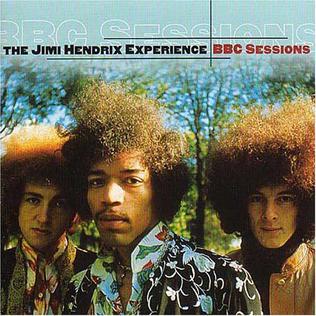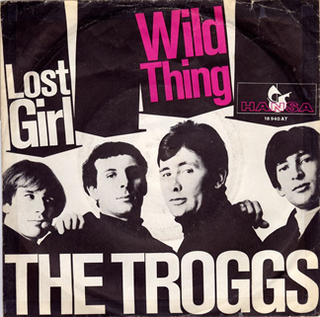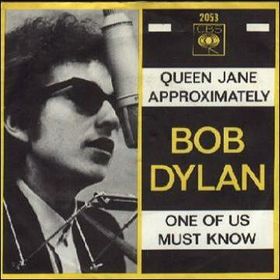
"All Along the Watchtower" is a song by American singer-songwriter Bob Dylan from his eighth studio album, John Wesley Harding (1967). The song was written by Dylan and produced by Bob Johnston. The song's lyrics, which in its original version contain twelve lines, feature a conversation between a joker and a thief. The song has been subject to various interpretations; some reviewers have noted that it echoes lines in the Book of Isaiah, Chapter 21, verses 5–9. Dylan has released several different live performances, and versions of the song are included on some of his subsequent greatest hits compilations.
"Mr. Tambourine Man" is a song written by Bob Dylan, released as the first track of the acoustic side of his March 1965 album Bringing It All Back Home. The song's popularity led to Dylan recording it live many times, and it has been included in multiple compilation albums. It has been translated into other languages and has been used or referenced in television shows, films, and books.

American singer-songwriter Bob Dylan has released 40 studio albums, 96 singles, 18 notable extended plays, 54 music videos, 15 live albums, 17 volumes comprising The Bootleg Series, 29 compilation albums, 22 box sets, seven soundtracks as main contributor, thirteen music home videos and two non-music home videos. Dylan has been the subject of seven documentaries, starred in three theatrical films, appeared in an additional eight films and 10 home videos, and is the subject of the semi-biographical tribute film I'm Not There. He has written and published lyrics, artwork and memoirs in 11 books and three of his songs have been made into children's books. He has done numerous collaborations, appearances and tribute albums. The albums Planet Waves and Before the Flood were initially released on Asylum Records; reissues of those two and all others were on Columbia Records.

"Like a Rolling Stone" is a song by American singer-songwriter Bob Dylan, released on July 20, 1965, by Columbia Records. Its confrontational lyrics originated in an extended piece of verse Dylan wrote in June 1965, when he returned exhausted from a grueling tour of England. Dylan distilled this draft into four verses and a chorus. "Like a Rolling Stone" was recorded a few weeks later as part of the sessions for the forthcoming album Highway 61 Revisited.

"I Am a Rock" is a song written by Paul Simon. It was first performed by Simon alone as the opening track on his album The Paul Simon Songbook which he originally recorded and released in August 1965, only in the United Kingdom. Paul Simon and Art Garfunkel, as the American folk rock duo Simon & Garfunkel, re-recorded it on December 14, 1965, and included as the final track on their album Sounds of Silence, which they released on January 17, 1966. It was released as a single in 1966, and subsequently included as the B-side of the 1971 A-side reissue of "The 59th Street Bridge Song ".

Bob Dylan's Greatest Hits is a 1967 compilation album of songs by American singer-songwriter Bob Dylan. Released on March 27, 1967, by Columbia Records, it was a stopgap between Dylan's studio albums Blonde on Blonde and John Wesley Harding, during which time he had retreated from the public eye to recover from a motorcycle accident.

BBC Sessions is an album of recordings by the rock group the Jimi Hendrix Experience, released on MCA Records on June 2, 1998. It contains all the surviving tracks from their various appearances on BBC radio programmes, such as Saturday Club and Top Gear, recorded in 1967.

"Quinn the Eskimo (The Mighty Quinn)" is a folk-rock song written and first recorded by Bob Dylan in 1967 during the Basement Tapes sessions. The song's first release was in January 1968 as "Mighty Quinn" in a version by the British band Manfred Mann, which became a great success. It has been recorded by a number of performers, often under the "Mighty Quinn" title.

"Positively 4th Street" is a song written and performed by Bob Dylan, first recorded in New York City on July 29, 1965. It was released as a single by Columbia Records on September 7, 1965, reaching No. 1 on Canada's RPM chart, No. 7 on the U.S. Billboard Hot 100, and No. 8 on the UK Singles Chart. Rolling Stone magazine ranked the song as No. 203 in their 500 Greatest Songs of All Time list.

"Just Like Tom Thumb's Blues" is a song written and performed by Bob Dylan. It was originally recorded on August 2, 1965, and released on the album Highway 61 Revisited. The song was later released on the compilation album Bob Dylan's Greatest Hits Vol. II and as two separate live versions recorded at concerts in 1966: the first of which appeared on the B-side of Dylan's "I Want You" single, with the second being released on The Bootleg Series Vol. 4: Bob Dylan Live 1966, The "Royal Albert Hall" Concert. The song has been covered by many artists, including Gordon Lightfoot, Cat Power, Nina Simone, Barry McGuire, Judy Collins, Frankie Miller, Linda Ronstadt, the Grateful Dead, Neil Young, The Black Crowes, Townes Van Zandt, and Bryan Ferry. Lightfoot's version was recorded only weeks after Dylan's original had been released and reached #3 on the Canadian RPM singles chart.

"Just Like a Woman" is a song by American singer-songwriter Bob Dylan from his seventh studio album, Blonde on Blonde (1966). The song was written by Dylan and produced by Bob Johnston. Dylan allegedly wrote it on Thanksgiving Day in 1965, though some biographers doubt this, concluding that he most likely improvised the lyrics in the studio. Dylan recorded the song at Columbia Studio A in Nashville, Tennessee in March 1966. The song has been criticized for supposed sexism or misogyny in its lyrics, and has received a mixed critical reaction. Some critics have suggested that the song was inspired by Edie Sedgwick, while other consider that it refers to Dylan's relationship with fellow folk singer Joan Baez. Retrospectively, the song has received renewed praise, and in 2011, Rolling Stone magazine ranked Dylan's version at number 232 in their list of the 500 Greatest Songs of All Time. A shorter edit was released as a single in the United States during August 1966 and peaked at number 33 on the Billboard Hot 100. The single also reached 8th place in the Australian charts, 12th place on the Belgium Ultratop Wallonia listing, 30th in the Dutch Top 40, and 38th on the RPM listing in Canada.

"Wild Thing" is a song written by American songwriter Chip Taylor and popularized by the English rock band the Troggs. It was originally recorded and released by the American rock band the Wild Ones in 1965, but it did not chart. The Troggs' single reached number one on the Billboard Hot 100 and number two on the UK Singles Chart in 1966. Their version of "Wild Thing" was ranked at number 257 on the Rolling Stone magazine's 2004 list of the 500 Greatest Songs of All Time. It has also been performed by many other musicians.
"It's All Over Now, Baby Blue" is a song written and performed by Bob Dylan and featured on his Bringing It All Back Home album, released on March 22, 1965, by Columbia Records. The song was recorded on January 15, 1965, with Dylan's acoustic guitar and harmonica and William E. Lee's bass guitar the only instrumentation. The lyrics were heavily influenced by Symbolist poetry and bid farewell to the titular "Baby Blue". There has been much speculation about the real life identity of "Baby Blue", with possibilities including Joan Baez, David Blue, Paul Clayton, Dylan's folk music audience, and even Dylan himself.

"I Want You" is a song by American singer-songwriter Bob Dylan, which was released as a single in June 1966, and, later that month, on his seventh studio album, Blonde on Blonde. The song was written by Dylan, and produced by Bob Johnston. The song has been interpreted as a straightforward expression of lust, although critics have highlighted that the symbolism of the song is complex. It was the last song recorded for Blonde on Blonde, with several takes recorded in the early hours of March 10, 1966. It was included on Bob Dylan's Greatest Hits (1967). The song has received a largely positive critical reception, with a number of commentators highlighting Dylan's use of imagery, although some of the meanings are obscure.
"She Belongs to Me" is a song by Bob Dylan, and was first released as the second track on his 1965 album Bringing It All Back Home. The song may be about a former girlfriend, Suze Rotolo, or fellow folk singer Joan Baez, contemporary siren Nico, or Sara Lownds, the woman that Dylan would wed in November 1965.

"One of Us Must Know (Sooner or Later)" is a song by American singer-songwriter Bob Dylan, which was released as a single on February 14, 1966, and as the fourth track on his seventh studio album Blonde on Blonde in June of that year. The song was written by Dylan and produced by Bob Johnston. It is the narrator's account of a burned-out relationship. It was recorded at Columbia studio A in New York on January 25, 1966, with Dylan and other musicians developing the song through over twenty takes during the session.
"One Too Many Mornings" is a song by Bob Dylan, released on his third studio album The Times They Are a-Changin' in 1964. The chords and vocal melody are in some places very similar to the song "The Times They Are A-Changin'". "One Too Many Mornings" is in the key of C Major and is fingerpicked.
"When the Ship Comes In" is a folk music song by Bob Dylan, released on his third album, The Times They Are a-Changin', in 1964.

"If You Gotta Go, Go Now" (sometimes subtitled "(Or Else You Got to Stay All Night)") is a song written by Bob Dylan in 1964. The first released version was as a single in the US by the UK group the Liverpool Five in July 1965, but this did not chart in the US despite receiving much airplay, particularly in the Pacific Northwest. Another British band, Manfred Mann, then issued the song as a single in September 1965 and had a number 2 hit. Fairport Convention also had a chart hit, with a French version, in 1969.

The Bootleg Series Vol. 12: The Cutting Edge 1965–1966 is a compilation album by American singer-songwriter Bob Dylan, released on Legacy Records in November 2015. The tenth installment in the ongoing Bob Dylan Bootleg Series, it comprises recordings from 1965 and 1966, mostly unreleased demos and outtakes from recording sessions for his groundbreaking albums Bringing It All Back Home, Highway 61 Revisited and Blonde on Blonde. The standard set peaked at #41 on the Billboard 200.















